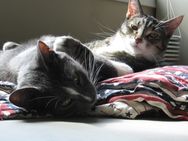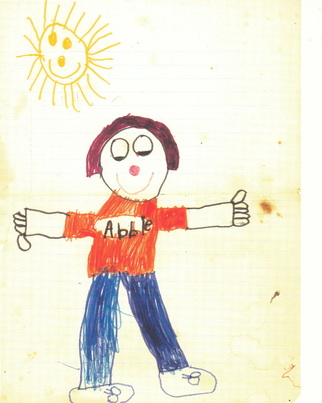Questions from Kids
Where did you grow up?
I grew up in Corning: a small town in southwest Iowa (population 1600). My dad was a farmer, and my mom a social worker. On our farm, we grew soy beans and seed corn, and raised cows and pigs, along with a handful of cats, dogs, and chickens. Most of my time was spent following my brother around, playing in various barns, coops, ditches, and fields. Corning still retains its Main Street, complete with single-screen movie theater, my favorite soda fountain, and music that wafts over the sidewalks. Do you have any pets? My two cats are named Cucamonga and Beazle. Cuca loves to play and chase things and often attacks feet in the middle of the night. Beazle has incredibly soft fur and is more likely to sit on your lap. His favorite thing to do is eat, which he tends to do too fast. Where do you get your ideas? I probably get my ideas from the same places you do: everywhere! Things that happen to me, things I read about in books and newspapers, things I remember from my childhood, and things that kids and adults tell me. One day I overheard a small boy in the park say, “But ducks don’t have lips!” Wouldn't that make a great book? Do you have any more books for us? Are you ever going to write another book? Yes! I have many more stories written, but books take a long time to create and even longer to publish. Here is the typical process each book goes through: 1. Write story (the easiest part) 2. Edit (the longest, hardest part) 3. Show to writing critique group. Return to Step 2 4. Create sketches or a storyboard 5. Research book publishers to find the best match 6. Send the story, sketches, and a "query letter" to publishers 7. Wait. And wait. 4-6 months is standard 8. If the reply is "no thanks", return to Step 3 and repeat, repeat, repeat What’s your favorite month? September. Falling leaves, cooling dusks, and the momentum of school starting, with its shiny new art supplies. What’s your favorite book? I don’t know how anyone can pick one favorite book.The book I’ve read the most times in my life is The Secret Garden, and the second is probably Stephen King’s Dark Tower series. When I was younger, I read Dr. Seuss books repeatedly; my current favorite picture books are: Roger is Reading, Llama Llama Red Pajama, Bear Snores On, The Day the Crayons Came Home, and everything by Shaun Tan and Mo Willems. Who's your favorite artist? Picasso and Dr. Seuss may be tied for my favorite artists of all time, but I also like Matisse (especially the paper cuts), Rembrandt, Nikki McClure, and Vik Muniz. My favorite illustrators are Shaun Tan, Rebecca Dautremer, Mo Willems, Steve Jenkins, and Oliver Jeffers. Do you have a hobby? I like hiking, jogging, rollerblading, building things for my house, board games, crossword puzzles, Oolong tea, making lists, watching movies, and reading, reading, reading. I especially like doing any of those things with other people. questions from Adults
Did you always know you would be an artist/writer?
Before I made my own pictures, I remember my mom drawing pictures for me to color in; I could spend hours with my crayons and markers. In Mrs. Morris’ 7th grade class, I wrote/illustrated a story called “The Very Big Nose” (of Annabel Rose) and I felt a real sense of accomplishment that I can still conjure today. Around this age, I recall thinking very clearly that “when I grow up, I’m going to be an author, an artist, an actress, or a pianist.” Growing up in a small town in Iowa granted me the chance to try all these things and I continue to love how different disciplines and mediums feed each other. A few other Aha! moments happened as I got older. In high school English, Mr. Nett had us journal every day, and that practice has stuck, central to my writing life. I didn't discover painting until college, but immediately fell in love with its looseness (as opposed to drawing — which I still have to force myself to do.) I had the great fortune to study in Italy and also traveled to West Africa, and both these experiences expanded my sight--and influenced my palette--for many years to come. It wasn't until I moved to Portland that I started meeting “real” artists and writers--and trying to become one myself. Did you go to Art School? Is Art School necessary? I went to American University, a small liberal arts college in Washington D.C. where I had some great art professors and lots of time to paint. These are the two things you will need most to form a career -- mentors and time -- and you can find them in various ways, without spending thousands of dollars. The best thing I did for my writing career was to spend two years interning for children’s author Elizabeth Rusch. I learned how to research, interview, transcribe, find and query publishers, edit, and generally approach my writing with more gravity. This also led to my writing critique group Viva Scriva, who are imperative to my career and sanity. I have a book idea. What do I do now? 1) Write, write, write. Edit, edit, edit. Repeat, repeat, repeat. Writing the first draft is only the tip of the iceberg, and editing is a skill you only learn by doing it repeatedly. So log your 10,000 hours, because Malcolm Gladwell and Macklemore are right. If you are an artist, follow the same advice, but substitute the word draw. Draw, draw, draw. 2) Learn everything you can about your industry. Join organizations and list serves. Find or form a critique group. Go to classes, workshops, and conferences. Here are some of my favorite resources:
But how do I get published? If you follow the steps above, you will arrive at your own best answer to this question.You can also read this handout for more direction. There are three avenues to publishing, and all of them require substantial work and a good deal of patience.
|


